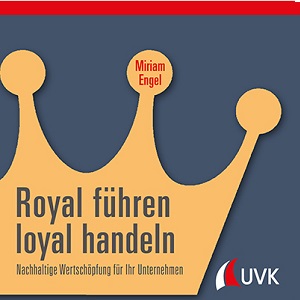Loyalty in companies – Part 1
Challenges in leadership today
What is loyalty?
Loyalty as behavior or attitude
That is (not) loyal! Taking action with attitude!
External influences put people to the test. When people feel under pressure, they tend to act out their characteristics even more than usual. The result: character traits increase. People who are normally more anxious tend to panic. Those who encounter the outside world with a pronounced composure may now react with indifference. And those who are usually hectic get caught up in wild actionism. In many companies, for example, a blind activity can be observed that, on closer inspection, leads nowhere and is merely mistaken for productivity. Still others go into shock and remain motionless for some time. But to drive meaningful change, we need awareness. We don’t need more revolutions per minute, but more reflection.
In business, we have long known that fundamental change is urgent and inevitable for companies. You may also have already taken initiatives to kick-start these, but somehow you can’t shake the feeling that these are mere cosmetics instead of radically addressing where it is effective. I see the problem in the fact that many people have (become) immune to change and would like to address how we can make it easier for ourselves to react to the complexity of our world – and to a certain extent to shape it pro-actively.
We create our future ourselves by adopting a certain mindset today, acting on it and thus shaping the future.
Challenges in leadership today
In my work with numerous leaders and teams, I notice a dynamic that tries to keep us stuck at the current stage of development and “protect” us from change. The discovery of “immunity to change” leads to the question of the motivations and beliefs that prevent leaders and decision-makers from making exactly those changes that are needed and required now. On the one hand, it should be clear that the current challenges cannot be overcome through classical learning. They require profound development at the attitudinal and behavioural level. Secondly, in order to deal effectively with the complexity outside, it is important to increase one’s own complexity, i.e. flexibility in thinking and acting.
Let’s take a look at three typical challenges in today’s leadership life in order to identify possible obstacles to loyalty here, but also to recognise the potentials that open up new perspectives and possibilities for action in leadership.
Challenge 1: Delegation of responsibility and informal information flow
Who is not familiar with this? Floor gossip, political tactics and hedging on all sides when something goes wrong or the risk is too great. Unfortunately often lived as a reflex, this tendency is difficult because it blames external factors or other people for the outcome.
Only when the leader understands himself or herself as part of this dynamic can he or she break through the typical self-protection and defence pattern and actively contribute to a solution.
Challenge 2: Toxic, artificial communication
One has become accustomed to not saying what one really thinks. The result is toxic communication. Although it may be thought, “Such a stupid idea will never work” it is more likely to be said, “Hmm, interesting”. This “cosmetic truth” is often applied where someone is torn: As a leader, should you be respectfully honest or rather purely factual, because that shows professionalism for you? Leaders should not be surprised in such a case if, despite all urgency, their message does not get through emotionally and meets with little emotional commitment.
These thoughts reveal a dilemma: if the leader says exactly what he/she is thinking, this risks a conflict, perhaps damages the relationship or makes him/her feel bad. On the other hand, if one chooses not to share the thoughts, the real problem is not articulated. Thus, the leader undermines the relationship and “poisons” him/herself by keeping quiet about it and letting these thoughts continue to work in him/her.
With loyal leadership awareness, a leader learns to manage his/her defences in an emotionally intelligent way and effectively “detoxify” the thoughts by gaining clarity that an internal toxic dialogue is happening reflexively. Furthermore, he/she recognizes that an additional internal conflict is created when a “cosmetic truth” is formulated that is neither authentic nor effective. Inner conflict also becomes visible externally and creates an impact. With an adapted attitude, the leader can anticipate and manage it accordingly – and remain authentic, effective and respectful.
Challenge 3: Allocating complexity
Adaptive or technical is a question you may ask yourself in the face of challenges. Adaptive challenges are not easy to solve because there is no clear link between cause and effect; the impact only becomes apparent in retrospect (example: Corona). And even that is not always the case. With many of today’s challenges, it is no longer possible to plan what the outcome will be. Those in positions of responsibility must of necessity accept uncertainty and a certain unpredictability in order to remain able to act. This requires profound reflection and development in the areas of values, beliefs, roles, relationships, communication and cooperation. It requires a willingness to step out of the comfort zone, to experiment and make new discoveries.
We have all learnt in recent years in dealing with change, globalisation, digitalisation – but few have evolved. Coping and handling are valuable skills, but they are not enough to master today’s and tomorrow’s challenges. Forward-thinking leaders therefore develop a conscious attitude, trust their inner resonance and mature as a personality. This enables them to have a high degree of flexibility and foresight in dealing with change.
For sustainable development, all members of a team are required to shift their thinking and live a new common mission:
- From pre-determination to self-responsibility,
- from control to self-control,
- from safety thinking to experimental thinking,
- from avoiding mistakes to trying things out,
- from the right to dissent to the duty to dissent,
- from consensus to dissent,
- from external determination to self-determination.
What is loyalty?
There are countless definitions of loyalty. Definitions from psychology, scientific and economic ways of looking at and interpreting it. To develop our own understanding of loyalty, let’s first look at how trust is defined as the basis for building loyalty.
Prof. Dr. Andreas Suchaneck of the Leipzig and Wittenberg School of Business, Centre for Global Ethics, describes trust in the Gabler-Wirtschaftslexikon as follows: “Trust is the expectation of not being disadvantaged by the actions of others; as such, it represents the indispensable basis of all cooperation. Trust is understood as a multidimensional construct that includes dimensions such as competence, integrity and goodwill. A distinction can be made between trust in persons and trust in systems. In interaction situations, trust is always related to responsibility; actors who are trusted have the responsibility to honour this in their own interest.”¹
Loyalty is not defined in the Gabler-Wirtschaftslexikon. Wikipedia states: “Loyalty (as distinct from fidelity, submission or obedience) is the inner bond based on common moral maxims or guided by a rational interest and its expression in behavior towards a person, group or community. Loyalty means sharing and representing the values (and ideology) of the other in the interest of a common higher goal, or representing them even if one does not fully share them, as long as this serves the preservation of the jointly represented higher goal. Loyalty is demonstrated both in behavior towards the one to whom one is loyally attached and towards third parties.
The degree of loyalty required depends on the expectations that are constitutive (decisive) for the respective relationship. These relationships can be informal (for example, friendships) or formal (for example, employees). One can be born into them (for example, kinship) or have chosen them (for example, immigration). Loyalty expectations extend to external actions, but also to internal attitudes. What is in dispute is whether loyalties are genuine (true, unadulterated) obligations.”²
Barbara feels at the end of her rope. She has been employed by her medium-sized company for 16 years and has made it to the second management level. But now this: first the sale and the integration into the new group of companies. Constantly new ideas are coming from the headquarters about which quality standards should be met and which process guidelines should be created. All well and good, but now is really not the time. The economy is on fire! Problems everywhere: in purchasing, in sales, in annual planning and in the team. Just one more and she can move right into the office and hang up her marriage. At home there is only stress because of all the overtime. She sees her two teenagers almost only on weekends. But she is so afraid! What if turnover collapses like in so many other companies? What if the new management discovers that she is actually only a trained industrial clerk? What if her branch has to close the day after tomorrow? Barbara can hardly sleep for worry.
Unfavourable behavior: lingering on the mental merry-go-round, talking things over with herself, isolating herself.
More promising behavior: talk about worries with confidants, have regular conversations for questions and answers with superiors on the one hand and the team or employees on the other, force team spirit and exchange: e.g. strengthen cooperation through a weekly team game (30-45 minutes), keep reminding the common vision (the greatest “common denominator”) and promote cohesion.
Loyalty is therefore the voluntary commitment to a person or an organisation through a positive attitude and willingness to stick together, even if there are no indications of trustworthiness at the current moment. The inner commitment is then due, for example, to a shared, positively perceived history and links the inner attitude with the emotional state towards the subject or object, so that binding behaviour results.
Loyalty as behavior or attitude
If loyalty is described and interpreted as a perceptible behaviour in the relationship between the employee and the company, the employee decides to stay with the company and a bond is created. However, it is important to distinguish that an employee’s loyalty behaviour can be both active and passive. Active loyalty is characterised by active action and support, while the passive form is characterised by restraint and patience.
Other behaviours that can indicate loyalty are, for example, long service with the company, support from colleagues and a high willingness to perform. Graham and Keeley³ distinguish three forms of loyalty in workplace problems:
- Unconscious,
- Passive and
- Reformist Loyalty.
Employees who are unconsciously loyal see no need to react, whereas passive loyal employees consciously take no countermeasures in the hope that something will change. Reformist loyalty, on the other hand, is characterised by active behavior in that changes are actively forced in order to give the situation a positive direction.
In contrast to the behavioural approach, attitude-based loyalty is defined as “a feeling of attachment to the organisation” and is often equated with the concept of organisational commitment. The latter means a strong acceptance of the company’s goals and values as well as the need to be part of the company. Three components are distinguished:
- Affective,
- Normative and
- Calculative Commitment,
each of which is characterised by a psychological state. Affective commitment describes the employee’s desire to maintain the relationship with the company. Normative commitment is based on a moral obligation that the employee should stay with the company. Calculative commitment focuses on the effort that an employee associates with leaving the company and which prevents him or her from leaving.
Key attributes that characterise loyalty are:
- Inclusiveness (degree of integration of an employee in the team, in his tasks, in the company),
- Identification with the company (stronger than a positive attitude towards the company alone) and
- Commitment.
Notes (partly in German):
That was Part 1 of the three-part series on “Loyalty in Companies”. Part 2 is about creating a loyal corporate culture and Part 3 is about the willingness to change through loyalty.
[1] Gabler Wirtschaftslexikon: Vertrauen
[2] Wikipedia: Loyalität
[3] Graham, J. W., & Keeley, M. (1992): Hirschman’s loyalty construct
Here you can find the other parts of the series and another article by Miriam Engel:
We are happy to recommend the German-language book Royal führen – loyal handeln by Miriam Engel. The tips and tools for implementing loyal leadership, retaining employees and optimising employee communication make the book well worth reading.
If you like the article or want to discuss it, feel free to share it in your network.

Miriam Engel
Miriam Engel is a communications specialist, leadership trainer and certified human resources developer. Her work focuses on team and cultural development as well as employee communication. With the management consultancy loyalworks®, she advises and supports companies that want to retain their employees in the long term and recruit suitable candidates for corporate growth. The expert for loyal leadership and cooperation also offers leadership programmes with IHK certification.
@Photo: Oliver Hehr



